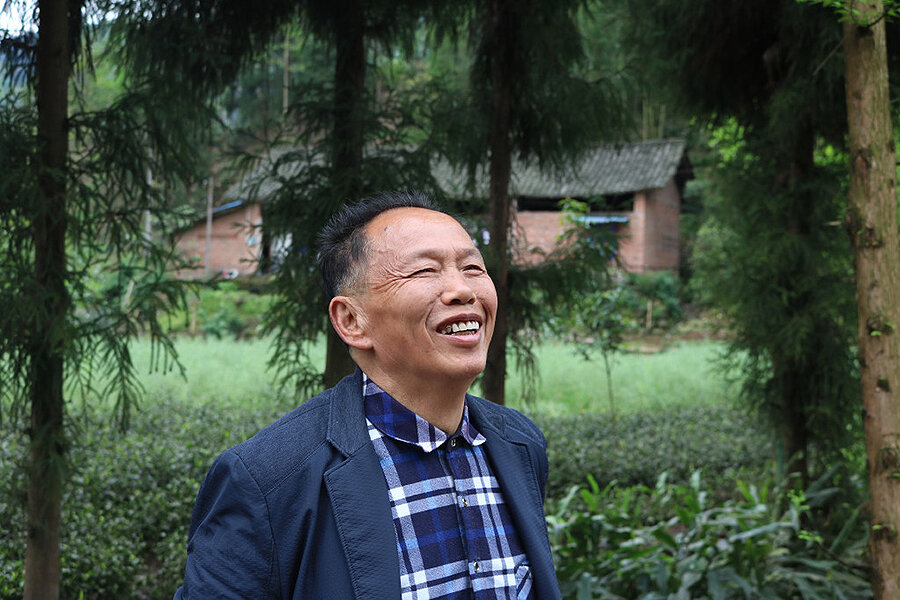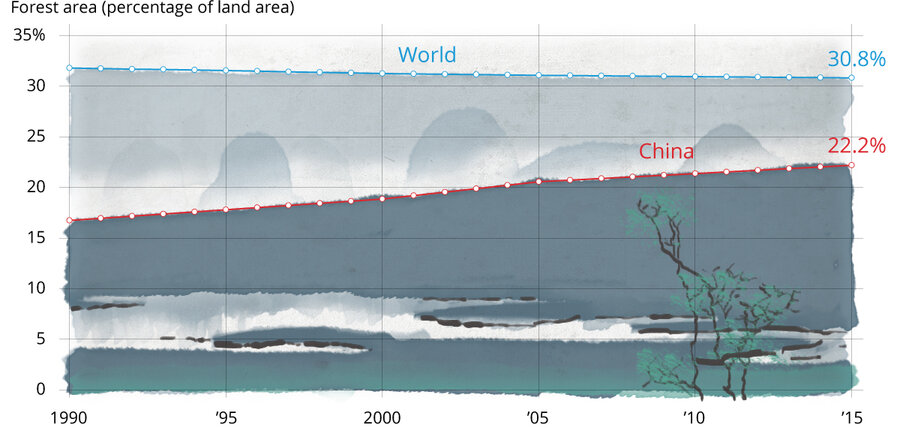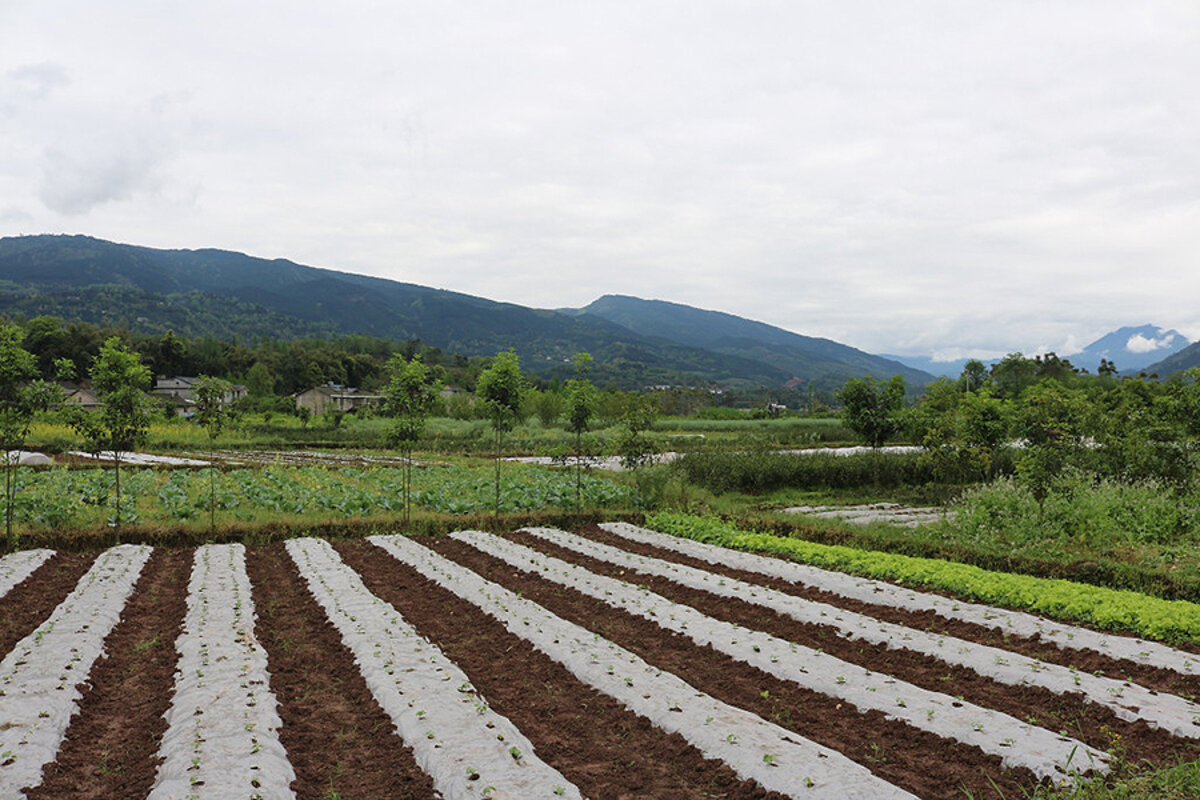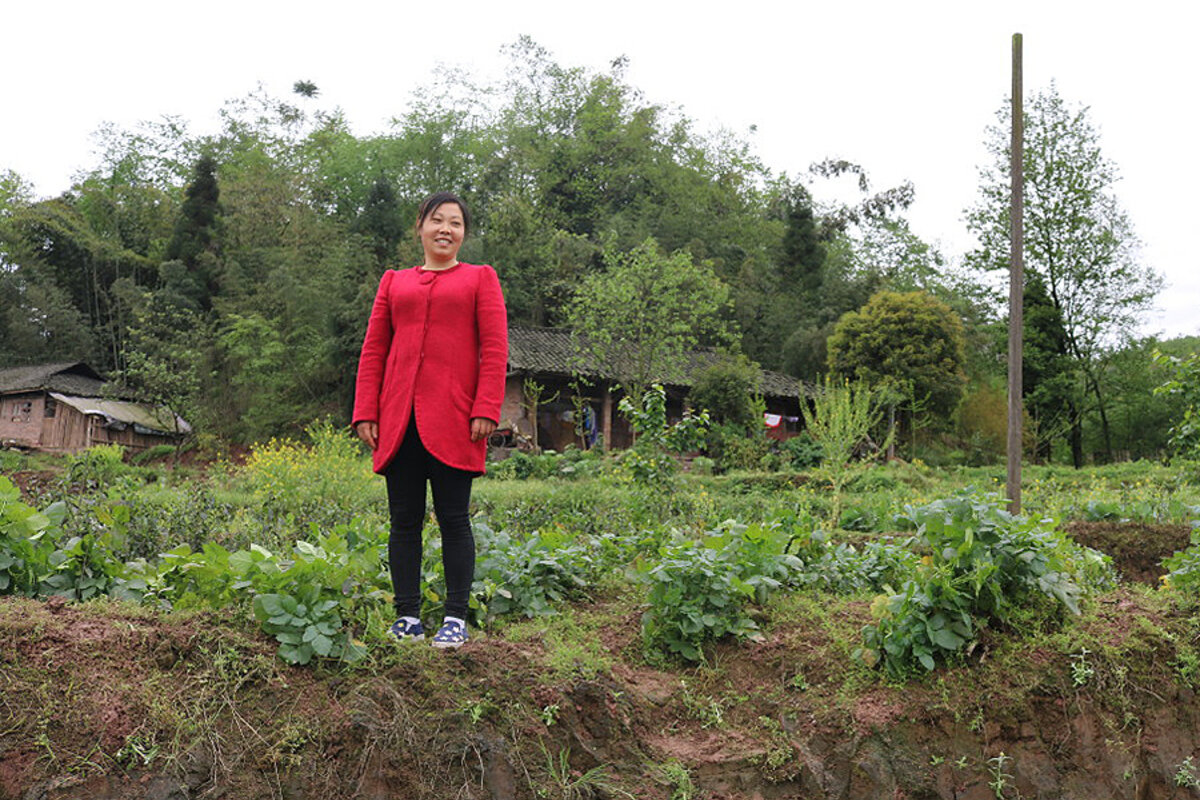China spent $100 billion on reforestation. So why does it have 'green deserts'?
Loading...
| Hongya County, China
Standing on a hillside, Liu Minfang looks down at the lush landscape that surrounds her home in the remote mountains of southwestern China. Terraced slopes that farmers once used for growing crops are now filled with cedar trees and bamboo. A waterfall cascades down a distant cliff. In the valley below, a muddy river flows through a patchwork of rapeseed fields and rice paddies.
The landscape has changed a lot since Ms. Liu was a child. The fields have long been here, but most of the trees are new, planted over the past 18 years as part of the largest reforestation effort in the world. China has spent more than $100 billion on trees in the last decade alone. Nearly 22 percent of the country is now covered in forest, compared to 19 percent in 2000, according to the Ministry of Environmental Protection. Places like Hongya County, Sichuan province, have been entirely transformed.
“It looks completely different,” says Liu, who is raising two young boys while her husband works in a car factory more than 600 miles away. “My children wouldn’t recognize the old valley.”
Much of China’s forest expansion comes from the Grain-for-Green program. Launched in 1999, the program has funded the reforestation of 31.8 million hectares, an area slightly larger than New Mexico, according to the State Forestry Administration. And the work isn’t over. In March, Premier Li Keqiang promised the government would restore 800,000 hectares of marginal farmland into forest and grassland, an area larger than Delaware.
After a half century of blistering economic growth, China is increasingly looking back at the environmental havoc it wreaked and searching for a greener path forward. It has boosted renewable energy, declared a “war on pollution,” and vowed to lower carbon emissions. But if Grain-for-Green is an indication, preserving biodiversity may represent a new challenge in China's push to go green: protecting and restoring natural spaces with an eye to not just quantity, but quality.
The program has drawn both admiration and skepticism from conservationists around the globe. Many have praised it for its sheer scale; others have pointed to its success in fortifying parts of China against natural disasters such as flooding and sandstorms. But recently scientists have discovered that large swaths of newly planted forests provide few habitats for China’s many threatened species of animals and smaller plants. The country’s biodiversity is at risk.
Xu Jianchu, a professor at the Kunming Institute of Botany, first warned that China’s new forests weren’t as green as they seemed in 2011. In an op-ed published in the journal Nature, he argued that government policies encourage the planting of fast-growing tree species, many of which are non-native and therefore unsuitable for local wildlife. More recently, in a study published in May, he suggests official estimates of China’s tree-planting campaign have overstated its successes, partially by mistaking shrubland for forests.
“Tree coverage is not the issue anymore,” says Dr. Xu. “But under the trees, it's empty. That’s the major problem we now face.”
Clear-cut hillsides
The lives of farmers in any country are inextricably linked to the land. This is something Zhang Xiugui, a 67-year-old farmer with thin black hair and dark eyes, has known well since he was a boy growing up in the countryside of Hongya County.
Back then, in the late 1950s and into the 1960s, Chairman Mao Zedong declared grain and steel production the key pillars of economic development. Mao’s goal was to achieve national self-reliance and rapid industrialization. Farmers plowed up pastures and clear-cut forests as the whole country was mobilized.
“Chairman Mao told us to make steel,” Mr. Zhang recalls, “so we cut down all the trees on the mountains.” Backyard kilns took their place. So too did corn and wheat fields, the result of Mao’s dictum to grow grain everywhere, along with a hundred pseudo-scientific schemes for better yields. China’s Great Leap Forward was underway.
Mao’s visions of socioeconomic engineering helped pave the way for the Great Famine, a subject that to this day remains taboo in China. More than 30 million people starved to death between 1958 and 1962; Zhang’s parents were among them. After they died, Zhang was taken in by a woman he came across at a nearby construction site. Together they survived off a diet of rice, green vegetables, radishes, and potatoes.
The Chinese government moved away from Mao’s economic policies in the late 1970s, but the environmental destruction left in their wake – to say nothing of the human toll – would take decades to undo.
A turning point came in 1998, when devastating floods along the Yangtze River in central China killed 4,150 people and caused an estimated $36 billion in property damage. The disaster was exacerbated by the shortage of trees along the river, which in the past had secured its banks and absorbed rainfall. From the 1950s into 1980s, the Yangtze River basin lost half of its forest coverage, causing severe soil erosion in 40 percent of the region.
The fear of reoccurring floods spurred the Chinese government to start the Grain-for-Green Program in 1999. The program works by paying farmers to restore forests and grasslands where they had previously planted crops, helping to better protect against flooding and landslides.
For each of the program’s first eight years, the government paid Zhang 700 to 800 yuan, just over $100, to plant cedar trees on his small plot of land. The government later cut Zhang’s subsidy in half and stopped it all together two years ago. Now he depends on money from his three children, all of whom found work in China’s flourishing cities. Zhang misses the subsidies, but he doesn’t miss what Hongya County looked like before Grain-for-Green.
“I prefer how it is now,” he says, standing on the side of a tree-shaded road. “The mountains are green and the water is blue.”
Unintended consequences
Since its launch in 1999, the Grain-for-Green program has had considerable success in achieving two of its primary goals: soil retention and flood mitigation. Both increased nearly 13 percent between 2000 and 2010, according to a government survey launched in 2012. The program has also helped many of the 32 million farming households it has enrolled climb out of poverty.
But as Grain-for-Green grew over the years, scientists began to wonder about its unintended consequences. Although the 2012 ecosystem assessment found that the program had helped improve everything from food production to carbon capture, biodiverse habitats were the one exception – they decreased 3.1 percent.
A study published last September in the journal Nature Communications raised more cause for concern. It found that the overwhelming majority of forests restored under the Grain-for-Green program contain only one tree species, creating monocultures that fall far short of native forests’ biodiversity. Hua Fangyuan, the lead author of the study and a research fellow at the University of Cambridge, says the shortfall is a missed opportunity.
“The land under the Grain-for-Green Program is in what’s typically called ‘working landscapes,’ or landscapes which support the livelihood of rural communities,” Dr. Hua says. “Although these landscapes are outside protected areas, there is increasing realization among the conservation community that they serve important roles for biodiversity conservation.”
Hua’s research revealed a significant drop in bird and bee populations, common indicators of biodiversity, at Grain-for-Green sites around Sichuan. Forests comprised of a single tree species actually support fewer species of birds and bees than cropland, the very land targeted for restoration. The few Grain-for-Green forests with two to five tree species are only slightly better for birds; bees were found to suffer from reforestation regardless.
“We call them green deserts,” says Wu Jiawei, a conservationist in Chengdu, the capital of Sichuan, who helped with the study. “The fear is that some species will disappear and never come back.”
Mr. Wu, an avid birdwatcher, is especially attuned to the changes caused by the Grain-for-Green program. The study found that forests planted under the program had 17 to 61 percent fewer bird species than native forests. The reason is most likely that these new forests don't have the diversity of resources, such as food and nesting habitats, necessary to support the ecological needs of many species.
Liu has noticed the changes too, if in more anecdotal ways. Her family still has a small vegetable garden and a hillside plot filled with a few dozen white tea plants, but most of their crops have been replaced with cedar trees and a scattering of bamboo.
“Sparrows now fly into our kitchen to look for food,” Liu says. “There are no longer as many crops for them to eat.”
Going native
The spread of monoculture forests isn’t the only threat to biodiversity in China. Environmental protections have taken a backseat to economic development across the country for much of its modern history, often with serious consequences.
The Chinese government has classified as threatened species – those likely to become endangered within the foreseeable future – nearly 3,800 kinds of trees, flowers, and other plants (10.9 percent of all vascular plant species found in China) and more than 930 kinds of fish, birds, mammals, amphibians, and reptiles (21.4 percent of all vertebrate species), according to the Ministry of Environmental Protection.
It gets worse from there, according to a report released last month by a group of Chinese conservation organizations. Of the 1,085 endangered plant and animal species in China the report examined, the habitats for 738 of them worsened between 2005 and 2015.The giant panda is a rare exception. The International Union for Conservation of Nature, a leading environmental group that tracks the status of plant and animal species, removed it from its endangered list last September. The panda is now classified as “vulnerable.”
As public awareness about environmental issues grows, the Chinese government has pledged to improve its conservation efforts. Yet it denies that the Grain-for-Green program has caused any harm. The State Forestry Administration, China's forestry regulator, says in an emailed statement that the program “protects and improves the living environment for wildlife” and that it has actually led to an increase in biodiversity in places like Sichuan. It blames the planting of monocultures to a lack of experience in the program’s early years and says it’s working to plant more mixed forests.
For now, the highest levels of government are pushing to keep the Grain-for-Green program and others like it alive as China seeks to remake its image as an environmental steward. President Xi Jinping has called to transform China into “the ecological civilization of the 21st century.” He has also stressed the country's potential as a global climate leader, particularly in the wake of the US withdrawal from the Paris climate accord. But the challenge is how to improve Grain-for-Green for the sake of biodiversity.
Hua and Xu see opportunity in a new government policy for ecosystems across China. Introduced last year, the draft policy says ecosystems should be protected based on their ecological value and the services they provide – services like flood mitigation and carbon sequestration – with compensation paid to local landowners. But in order to improve reforestation, the policy should encourage the restoration of native forests and include biodiversity as an explicit goal, say Hua and Xu, who are working alongside Princeton University ecologist David Wilcove on related research.
“Now that we have the political will to restore China’s forest landscape, why aren’t we doing it more properly?” Hua asks. “There is this missed potential. China can do better.”
Xie Yujuan contributed reporting.








